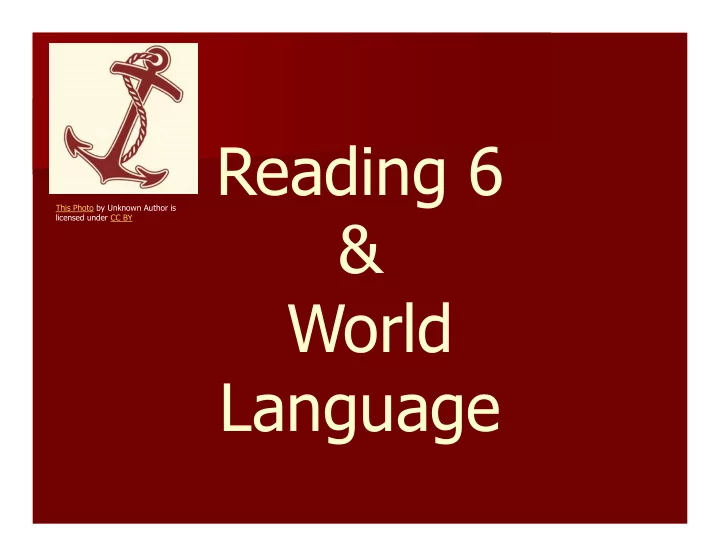

Reading 6 This Photo by Unknown Author is & licensed under CC BY World Language
“Learning to Read” vs. “Reading to Learn” Elementary school : 90 minute block Middle school : English and Reading as separate classes (87 minute blocks) Students are required to read increasingly complex texts to acquire, analyze and apply content.
Reading English Alignment English 6 Units Unit 1: Unit 2: Unit 3: Unit 4: Unit 5: Narrative Fiction + Exploring and Exploring and Literacy Café Research Inquiry Craft Your Story Analyzing Non-fiction Analyzing Fiction & Project + Writing to Inform Poetry + Responding to Reading Reading short stories Non-fiction reading Short story or novel Skills review + Research + creating + writing personal skills + informational study + literary Personalized an infographic narratives writing + digital essays Learning Task writing & oral presentation Reading 6 Units Becoming a Lifelong Nonfiction - Not Just Reading to Inspire Strategic Reading for Characters in Conflict Reader the Facts! Action the Future
Reading 6 aims to… 1. Transition students to be successful in content area reading by: – Reading critically – Engaging in metacognitive processes – Utilizing note taking strategies – Studying etymology and vocabulary – Tackling nonfiction academic reading 2. Promote reading for pleasure by: - Fostering a love of reading and building a reading life - Increasing volume and choice
Reading Reasons 1. Reading is rewarding. 2. Reading builds a mature vocabulary. 3. Reading makes you a better writer. 4. Reading is hard, and “hard” is necessary. 5. Reading makes you smarter. 6. Reading prepares you for the world of work. 7. Reading well is financially rewarding. 8. Reading opens the door to college & beyond. 9. Reading arms you against oppression. Reading Reasons: Motivational Mini-lessons for Middle and High School Kelly Gallagher, 2003
6 Critical Reading Habits 1. Preview 2. Annotate 3. Outline, Summarize, and Analyze 4. Identify author’s purpose through text structure 5. Contextualize 6. Compare and Contrast Interrogating Texts: 6 Reading Habits to Develop in Your First Year at Harvard Susan Gilroy, Librarian for Undergraduate Programs for Writing, 2011
4) SOL 7.4 Using words or phrases from the list, complete the chart to match the word and the meaning of the affix. novelty WORD MEANING OF AFFIX badly childish having the character a person who state or quality hospitable malpractice apart
from Collecting Rocks by Rachel M. Barker 6) SOL 6.6 Rocks are continually changing. Wind and water wear them down and carry bits of rock away; the tiny particles accumulate in a lake or ocean and harden into rock again. The oldest rock that has ever been found is more than 3.9 billion years old. The Earth itself is at least 4.5 billion years old, but rocks from the beginning of Earth’s history have changed so much from their original form that they have become new kinds of rock. By studying how rocks form and change, scientists have built a solid understanding of the Earth we live on and its long history. Which is the best heading for this paragraph? Rocks Tell the Story of the Earth Types of Rocks that Change Tiny Particles Make the Earth Identifying a Rock’s Age Grade 6 SOL Reading Questions
Half Year vs. Full Year Reading Full year Reading 6 offers opportunities for cross-curricular work, project-based application, and practice, focusing on the development of the reader. To participate in Half Year Reading 6, students have to : - Demonstrate grade level reading proficiency - Be able to retain information as it is a semester class and read at home nightly
6 th Grade World Language Class Options: Introduction to Latin Introduction to French Introduction to Spanish Transitional Spanish 6 th grade Spanish for Fluent Speakers
Introduction to Latin, Spanish and French What it is… What it is NOT… The goal is language It is not a prerequisite exposure for students for a level one in a semester long language class. class. It is not for high school credit. It is not a requirement for 6 th grade students.
Transitional Spanish - Students with 3+ years of FLES or similar exposure
Spanish for Fluent Speakers for 6 th - For 6th grade students who demonstrate native or near native Spanish oral proficiency
Which schedule is best for your child? Factors to consider when deciding: **Student motivation **Parent observation **Teacher recommendation **Current reading level **SOL scores and grades
Thank you! Feel free to contact us with individual questions: Reading: French: cynthia.chiu@apsva.us leigh.rauseo@apsva.us hayley.corey@apsva.us paul.perrot@apsva.us linda.kelleher@apsva.us jean.samuel@apsva.us Latin: melanie.stowell@apsva.us Spanish: maritza.carpenter@apsva.us kelly.darling@apsva.us lisa.mullet@apsva.us This Photo by Unknown Author is licensed under BY-SA
Recommend
More recommend